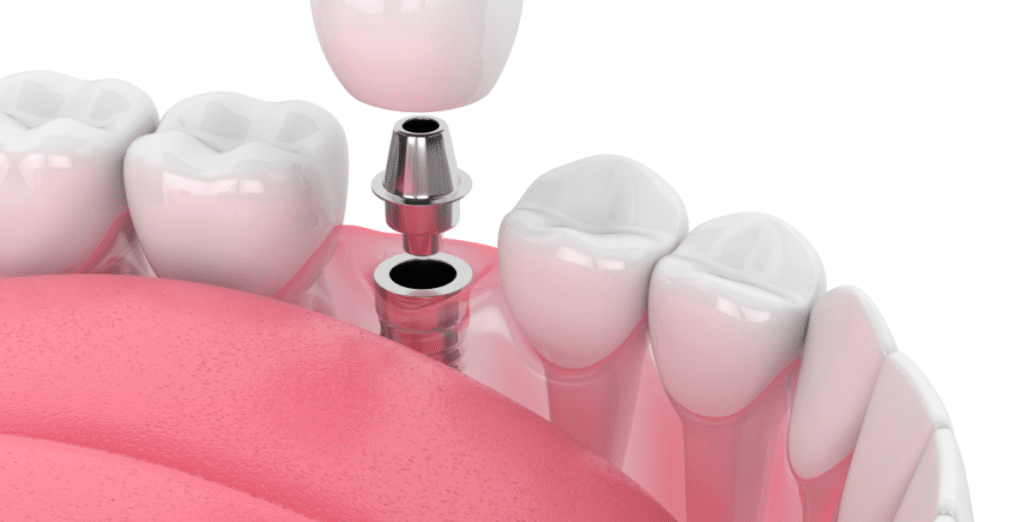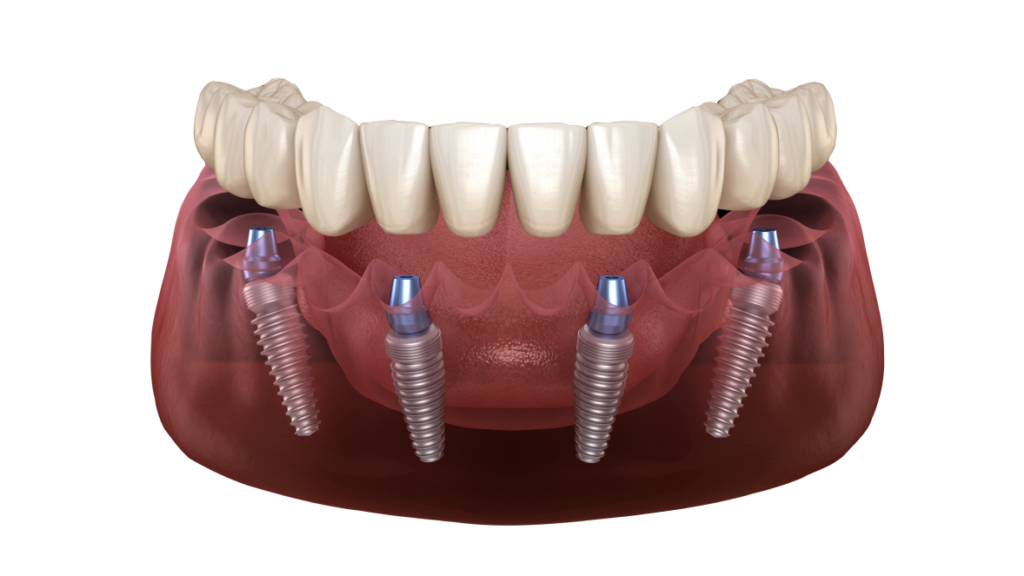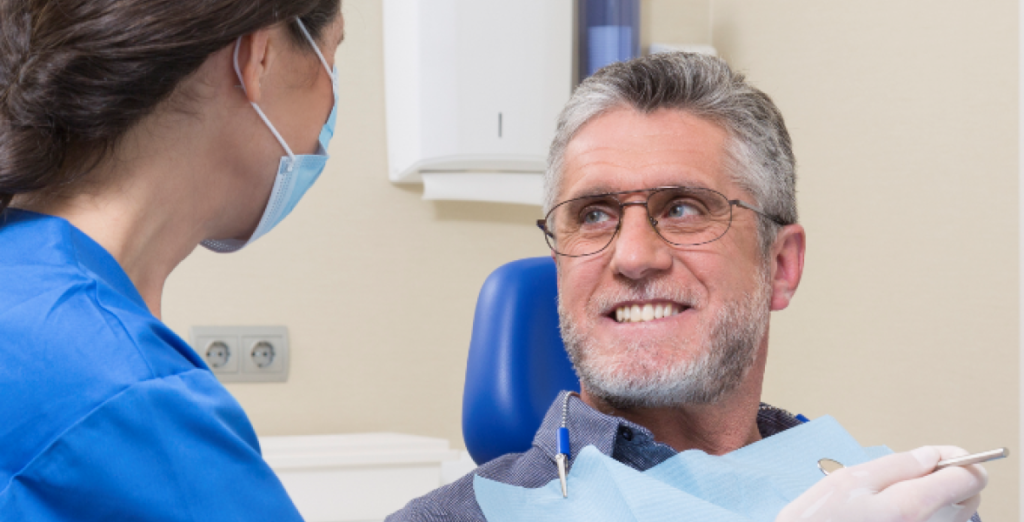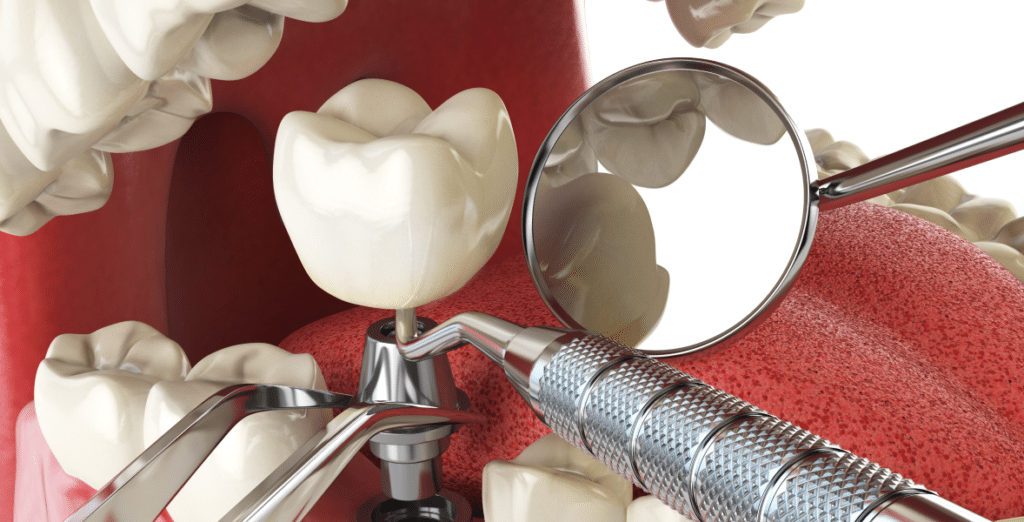This treatment is for you if…
You want to bite better and improve your quality of life.
What are dental implants?
Dental implants are a solution to replace missing teeth. A dental implant is a titanium screw introduced into the maxillary bone, on which crowns or prostheses will subsequently be fitted, which substitute the aspect and functionality of the missing tooth.
95% of dental implants are made of titanium, since it is a biocompatible material that permits osteointegration, that is, the fusion with the bone. Despite the fact that there are no known reports of patients that have suffered an allergy or reaction to titanium, some people with an allergy to other metals have shown themselves to be reluctant to use titanium in their dental implants. As an alternative, zirconium implants exist, which are not as versatile as titanium ones, since they only have one piece and not two like titanium implants.

What types of dental implants exist at Adeslas Dental?
To substitute the functionality and aspect of the tooth, prostheses are used in the case of various absences of adjacent teeth and crowns if the absence affects one tooth, which is placed over the dental implant.
Types of dental prostheses over dental implants.
- Removable prostheses over dental implants (mucosa-supported prostheses). They are also placed over dental implants, with the difference that the patient can remove them to clean them and sterilise them. They are normally placed on patients that have no teeth at all.

- Fixed prostheses over dental implants. They are placed directly over the dental implants and are usually made of porcelain, which gives them an aspect exactly the same as a natural tooth. They do not need to be removed to be cleaned, nor do they move on chewing or eating.
Tipos de coronas dentales sobre implantes.
There are two types of crowns for dental implants, depending on the material with which they are made:
Metal-porcelain crown
They are made of metal inside and they are covered with porcelain to be able to imitate natural teeth, but they are not very translucent due to their nucleus. If the gum retracts, a small metallic arch can be seen on the edge. These crowns are recommended for teeth situated in the back part of the mouth and they are more economical.
Zirconium crown
They are 100% made of zirconium and 100% biocompatible, offering a more aesthetic result, since they are translucent, looking a lot like natural teeth. They are the most common type for implants in front positions of the mouth and they are more expensive.n más caras.
Advantages of dental implants
People that decide to have dental implants fitted to replace missing teeth have multiple benefits, both practical and aesthetic. On once again having all their teeth, they begin to make movements and gestures normally when eating, drinking and smiling, which improves their aesthetics and their physical and mental health.
Notable advantages include:
- You recover full functionality of your mouth on regaining all your teeth.
- You can talk and pronounce without difficulties, since your tongue can move naturally.
- You can chew correctly, without having to think about that tooth that is missing.
- Your digestion improves, on being able to correctly chew food again.
- You recover your smile, without fear of exposing missing teeth, which also improves your self-esteem.
Advantages over other treatments, such as removable prostheses.
- They are more comfortable. On being fixed, implants do not need to be attached with cement nor do they have to be removed to be cleaned at night as with removable prostheses.
- Greater durability. With good care, dental implants last many years.
- More tasty food. Dental implants do not cover the palate, as is the case with removable prostheses, so the sense of taste is improved.
- Improved fixation. On merging with the bone, dental implants do not run the risk of moving, being displaced or falling out during their use, hence the patient can eat all foods without fear of them falling out.

Dental implant treatment phases
Dental implant treatment is carried out in various phases:
1. Implantological study. A personalised assessment is made of the case, in which aspects such as bite and the shape of the mouth are studied. X-rays are necessary, which may include 3D scans or computerised axial tomography (CAT) scans. This study helps to correctly position the dental implant in the bone.
2. Placement of dental implants. The surgical procedure begins with the application of anaesthetic in the indicated area. With the anaesthetised area, the bone is prepared in which the implant will be housed through a sequence of burrs introduced from the smallest to the largest. Once drilled, the implant will be placed and, if necessary, the injury will be sealed with stitches.
3. Integration of the dental implant into the bone and tissue. Following the surgical procedure, the fusion of the titanium dental implant with the bone takes from two to sixth months. Once merged, the definitive prostheses can be fitted.

4. Placement of the dental prostheses. Once the dental implant has been perfectly integrated, imprints will be taken to manufacture the new teeth. Tests are performed to ensure the aesthetics and functionality of the new teeth and they are cemented or screwed onto the implant.
5. Recommendation of stress-breaker mouth guard. To protect wear and tear, both of your dental implants and the porcelain prostheses, the use of a stress-breaker mouth guard is recommended. Dental implants do not have periodontal ligatures so they do not cushion the chewing forces and the prostheses can suffer overloads. Furthermore, porcelain is more fragile than dental enamel, so you must protect it even more.
6. Maintenance and hygiene. Once the process has been completed, it is important to maintain daily oral hygiene, including brushing and the use of dental floss. Lastly, it will be necessary to regularly visit the odontologist and hygienist, to ensure that the operation has been successful and that the implant is stable and that the crowns or prostheses have been correctly placed over it.
New dental implantology technology: Guided surgery and immediate loading
This technology generates three dimensional images of the mouth, enabling professionals to virtually study, diagnose and plan the implantological treatment in detail with greater accuracy.
A CAT scan and a specialised IT programme generate 3D images, allowing a study of the best treatment possible to then apply the best technique, improving the effectiveness of the implant’s position, reducing the operation time and minimising inflammation after the operation and, on occasions, enabling the teeth to be placed instantly.
What is computer-guided surgery?
Firstly, the patient undergoes a CAT scan to subsequently plan the treatment on the three-dimensional image on the computer. Models are also taken of the patient’s mouth. A mouth guard or guide is prepared to locate the orifices in which the burrs and implants should pass and, lastly, the minimally invasive surgery is performed.
What are the advantages of this technique?
Technically, it allows the dental implants to be placed in the most suitable position with regard to the quality and amount of the bone, thereby supporting the future prostheses. Furthermore, it is not necessary to open the gum, so the post-operatory period is easier to bear for the patient, reducing pain and inflammation to a minimum.
What does the immediate loading of the implants involve?
Since a preliminary planning has been conducted of the exact location in which the dental implants will be placed, provisional teeth can be prepared, which will be anchored to the recently placed implants, achieving an aesthetic and functional situation that is easier to bear for the patient until the placement of their definitive prosthesis.
In addition to these new technologies, a further step has also been taken in the prosthetic part of the treatment with the use of dental scanners, allowing the manufacture of the prostheses without the need to take imprints and, on occasions, without the need to carry out verification and adjustment tests, thereby ensuring less inconvenience and fewer appointments for the patient.
There has also been progress in the prosthetic laboratory phase, allowing prostheses to be designed digitally and manufactured by computer-guided planing machines.
Frequently asked questions
Dental implants are artificial substitutes for teeth roots, used to restore them when they have been lost. They are generally made of titanium and are inserted into the top and bottom jaw bone, where they are linked with the prosthesis that replaces the visible part of the teeth.
Ideal candidates for dental implants are those with good general and oral health, sufficient bone density in their jaw and without chronic illnesses that can affect the ability of the implant to integrate into the bone. A detailed assessment with a specialised odontologist is required to determine suitability.
The process to fit a dental implant generally implies various stages, including an initial appointment, planning, the implant surgery itself and then the healing phase, which may last various months. Lastly, the crown or dental prostheses is fitted.
Dental implants can last many years, even forever, if they are correctly looked after. This includes regular brushing, the use of dental floss, interproximal brushes or water irrigators, regular dental visits and avoiding bad habits such as smoking.
Although dental implants have a high success rate, there are possible risks and complications, such as infections, nerve damage, problems with the integration of the implant into the bone or complications with the prosthesis. Choosing an experienced odontologist and following their recommendations may minimise such risks.
Prices
The amounts indicated have been estimated in line with a full treatment, in accordance with the parameters in the table.
Includes: study, treatment and check-ups during the treatment, so it serves as a guide and is of a merely informative non-contractual nature. The personalised treatment will be examined in line with the medical prescription. Prices can be increased if additional costs are incurred as a result of the requests made by each customer. Price valid until 31 December 2024 except in the event of a typing error.



